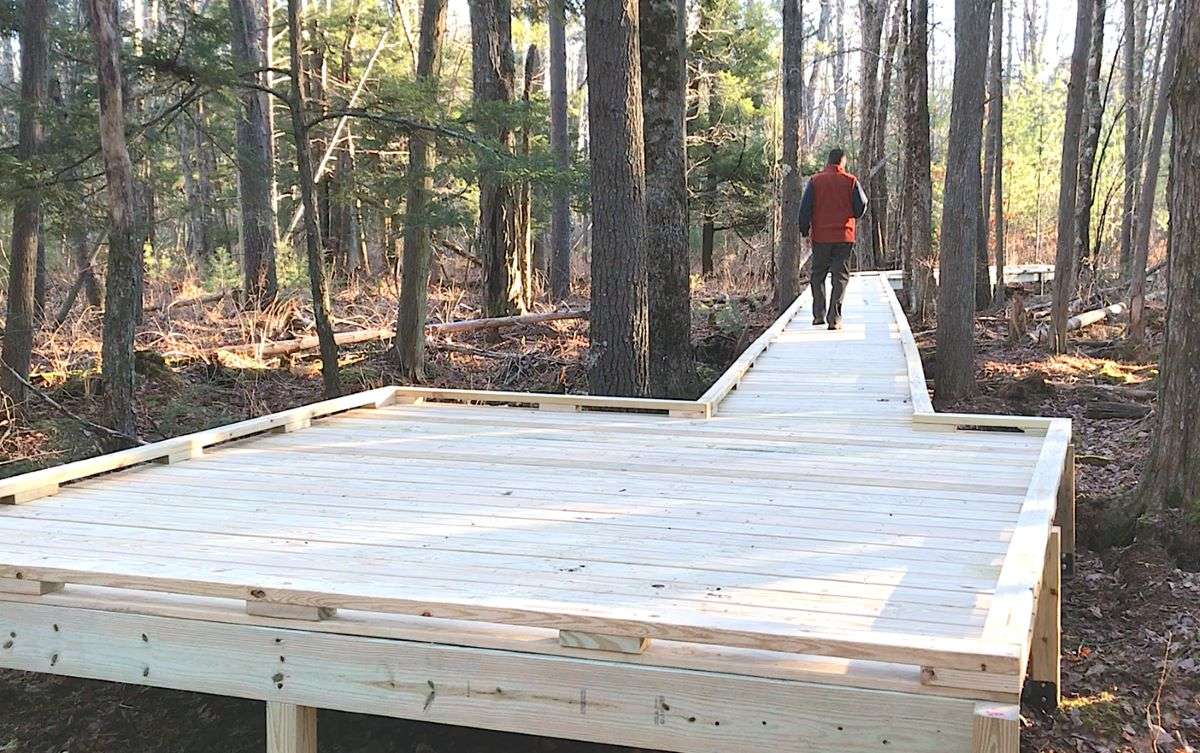Out In The Woods
- April 11th 2024
- Out in the Woods

Steve Mallon walks on the boardwalk that he and other members of the Mousam Way Land Trust built to access the Atlantic White Cedar Swamp at Great Works Reserve
Rare Cedar Swamp Offers Shady Coolness
Photo: Kevin McKeon
By Kevin McKeon, Director, Mousam Way Land Trust
As you walk the footpath at Mousam Way Land Trust’s Great Works Reserve next to Sand Pond, you’ll walk past a thick, young, white pine stand. After that, you’ll find yourself in the midst of a rare pitch pine/scrub oak forest. Rarer still along this one-third mile footpath is the damp, shady coolness experienced under the dark green forest canopy offered by the trees in your next forest-bathing area. Walking 100 feet upon a recently built boardwalk to a roomy viewing platform, this cool dampness with little light invites the growth of many types of mosses, a few blueberry shrubs, colonies of sheep laurel, cinnamon fern and starflower, and other flora that “like their feet wet,” such as skunk cabbage. This soil that is wet or damp most of the year, but rich in minerals and covered with a layer of peat, holds the key to a wondrous Atlantic White Cedar Swamp.
Here in southern Maine, Atlantic white cedar is at its northern-most range. Along with special soil, the areas also need to be less than 300 feet in elevation, so this limits their habitat to the southern coastal plain, found between the ocean and the rolling hills of land further inland. In Maine, the southern forested wetlands are the only areas where conditions are favorable for Atlantic white cedar’s existence, but habitat loss is the major contributor to this species decline. Southern Maine is experiencing rapid housing growth, adding to this species’ decline.
The wood of Atlantic white cedar is very resistant to rot and insect damage; this makes it quite valuable, and all of Maine’s forest stands have been previously harvested. In this area, many trees were cut to provide the wooden railroad ties of early rail roads and for wooden docks along the coast. These stands have now mostly reached maturity and will succumb to being blown down due to weakness. Atlantic white cedar regeneration will be dependent upon keeping competition from other tree species, like red maple, black ash, and hemlock, that like the same habitat from becoming established. Historically, naturally occurring forest fires helped regeneration by burning the other trees, which allows the seeds from the Atlantic white cedar to out-perform the germination and growing race in the wet, acid soil.
Atlantic White Cedar swamps are one of the rarest forest types in the eastern U.S. In Maine, it is ranked as “Imperiled,” and the trees are listed as a “Species of Special Concern.” This means the species will become endangered without protection from housing development growth. And speaking of endangered, Atlantic white cedar trees are the only thing that the endangered Hessel’s hairstreak butterfly caterpillars can eat. You can read about them on the placard on the trail’s platform. Although the forested wetland where Atlantic white cedar lives is recognized as imperiled, and some level of protection is offered, this area is in danger of losing its health due to the encroachment of development along the dryer, easier-to-build-upon upland borders of the swamp. The trees, shrubs, and other vegetation along the swamp’s border act as a natural filter, helping to clean the air and water pollutants before they can enter the wetland. Also, the new homeowners tend to use fertilizers, bug sprays, and weed-killers on their lawns and landscaping; this added “run-off” enters the water and air stream into the swamp, further degrading the trees’ habitat. With the removal of Nature’s natural filter, the cedars’ survival is imperiled.
So, find Great Works Reserve’s parking area at the end of Great Works Drive, off Sand Pond Road, and enjoy the cool habitats within Great Works Reserve and actually walk into the rare Atlantic white cedar swamp along the boardwalk.





